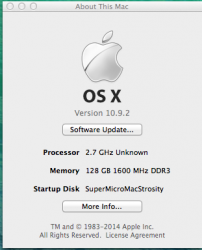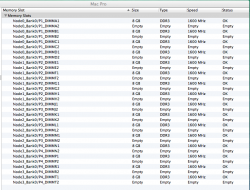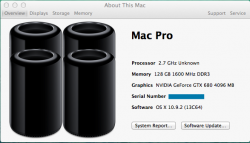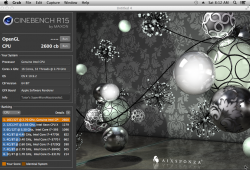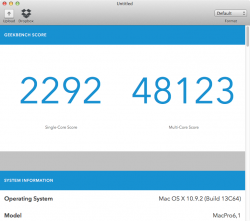Where might the Titan-Z and its $3k price tag fit?
Many of the creators of GPU-based rendering solutions recommend Nvidia’s GTX CUDA based lineup over the Tesla cards. So I would not relegate the Titan-Z to “entry level compute.” Fortifying my observation that Titan-Z is not “entry level compute” is the fact that there are a whole host of less capable GTX CUDA cards that can be had for less money and that satisfy many content creators’ needs. Without question,
Titan-Z has more compute power than any other single GTX card and
any announced or released Tesla card. But the question is where does it fit, for whom does it fit and who will pay the $3k passage fee. It doesn’t fit me for what I do right now. But things can and, I suspect, will change. What and how many gamers and content creators are going to spend $3k on a 3 PCIe slotted GPU, when the other lower priced and capable GTX solutions exist. Below, I’ve posited one candidate. Are there others? Might the card also be touted by Nvidia as a top end gamer’s card because that’s perceived by Nvidia as a large market? Where’s 5K gaming? Looks to me like Nvidia might have constructed a hole, from ground up, about itself by pricing the Titan-Z at $3k. With earlier generations of duo GPU cards, 99 dollars and/or 99cents was used to stay under certain price points. E.g., the GTX 690 was $999.99. But that card cost a lot more than the GTX 590’s $699 price [
http://en.wikipedia.org/wiki/List_of_Nvidia_graphics_processing_units ] and the GTX 590 cost a lot more than the GTX 295’s $499 price [
http://www.tomshardware.com/reviews/geforce-gtx-295,2107-11.html ]. There was no duo GTX 400 and the 300 line was not much to speak of and it too didn't include a duo GPU card. My point is that historically, duo GPU Nvidia cards have costs more each generation. But does this fly in the face of what we see happening to the lowering of prices of other electronics over time. And although supplying a duo GPU card (with apparent added performance) certainly ought to justify some increase in price over the single GPU card version, does there come a point at which the added price begins to border on the ridiculous or have real appeal to only a very, very small user population, such that all it really does is make the statement, “See what we can do for you
if you can afford it.”
There is, at least, one sort of individual workstation system where a Titan Z makes perfect sense. That’s the PCIe slot limited system like one using the Supermicro (“SM”) Dax line of motherboards -
http://www.supermicro.com/products/motherboard/Xeon1333/#top . It’s one of the few motherboard series made by SM with any overclocking ability and its incredibly stable overclocking. The Sandy Bridge CPU Family (including the Ivy Bridges) can be overclocked at most 1.0755%. The folks that I know with Dax motherboards have almost, without exception, been able to get the highest overclock possible using the Dax line. The Dax boards sell from the low $500s to the high $800s, depending on the special added features, but, so far, there’s really only 1 full double wide x16 PCIe slot on any of them, unless you put the GPU in a case that has more slots at the bottom of the case fully below the motherboard for the GPU to breathe if you put the GPU in the lowest/2nd X16 slot. The two X16 slots are side by side with no real slot space between them and the slots lay at the end of the board (see "quick view" pics in URL). For someone who wants the fastest two CPU Sandy/Ivy Bridge system (say - dual Intel Xeon E5-2697 v2 [
http://www.cpu-world.com/CPUs/Xeon/Intel-Xeon E5-2697 v2.html ] overclocked to run 24 cores at 2.90 GHz base (vs. 2.7 GHz) and one from each CPU at 3.76 GHz at max turbo (vs 3.5)
*/, with a powerful 5076 CUDA core GPU, the Dax + Titan Z combo would be one of the faster 2 CPU/GPU self-build combinations on the market. Superbiiz sells the Dax barebones system [ Supermicro SuperWorkstation SYS-7047AX-72RF Dual LGA2011 1280W 4U Rackmount/Tower Server Barebone System (Black) ] for $1,758 [
http://www.superbiiz.com/detail.php?name=SY-74772RF ]. Because it’ll hold up to 512 gigs of ram, setting up a huge ram disk (e.g. 384 gigs) that would be many times faster than a PCIe based solution, shouldn’t be a problem.
DAX CPU
A properly cooled system would likely show, via CPU-z or the like, that an overclocked Dax system under almost any light load will be running 24 cores at 3.23 GHz. Moreover, I project that such a system would achieve a Geekbench 3 score in excess of 57,000.
Titan-Z GPU
A Titan-Z will likely be about about 2x faster than the GTX 780 Ti. A GTX 780 Ti (renders the Octane Benchmark scene in 72 sec.) is about 1.32x faster than the original reference design Titan (with the GK110A) (renders the same Octane Benchmark scene in 95 sec.) in 3d rendering with OctaneRender. Therefore, a single GTX Titan-Z should be about 2.64 times faster than the original Titan in CUDA rendering performance. Thus, it should render the same Octane Benchmark scene in 36 sec. As an aside, two GTX Titan-Zs should render that scene in 18 sec., four Titan-Zs should render that scene in 9 sec. and eight Titan-Zs should render that scene in 4.5 sec. That’s the way linearity works in Octane.
*/ The full breath of turbo stages should shake out like this per CPU [
http://www.tomshardware.com/reviews/ivy-bridge-ep-xeon-e5-2697-v2-benchmarks,3585-2.html ] going from highest GHz to lowest:
1) one core - 3.5 GHz standard vs. overclocked on Dax - 3.76 GHz;
2) two cores - 3.4 GHz standard vs. overclocked on Dax - 3.66 GHz;
3) three cores - 3.3 GHz standard vs. overclocked on Dax - 3.55 GHz;
4) four cores - 3.2 GHz standard vs. overclocked on Dax - 3.44 GHz;
5) five cores - 3.1 GHz standard vs. overclocked on Dax - 3.33 GHz and
6) six to twelve cores - 3.0 GHz standard vs. overclocked on Dax - 3.23 GHz .
So in a dual E5-2697 CPU Dax-based system one could like get turbo stages like this:
1) two cores - 3.76 GHz;
2) four cores - 3.66 GHz;
3) six cores - 3.55 GHz;
4) eight cores - 3.44 GHz;
5) ten cores - 3.33 GHz and
6) twelve to twenty-four cores at 3.23 GHz.
P.S. The Supermicro barebones system appears to have the necessary space below the last/bottom X16 slot on the motherboard to allow the installation of a triple wide GPU, such as the Titan-Z, in that last X16 slot.


